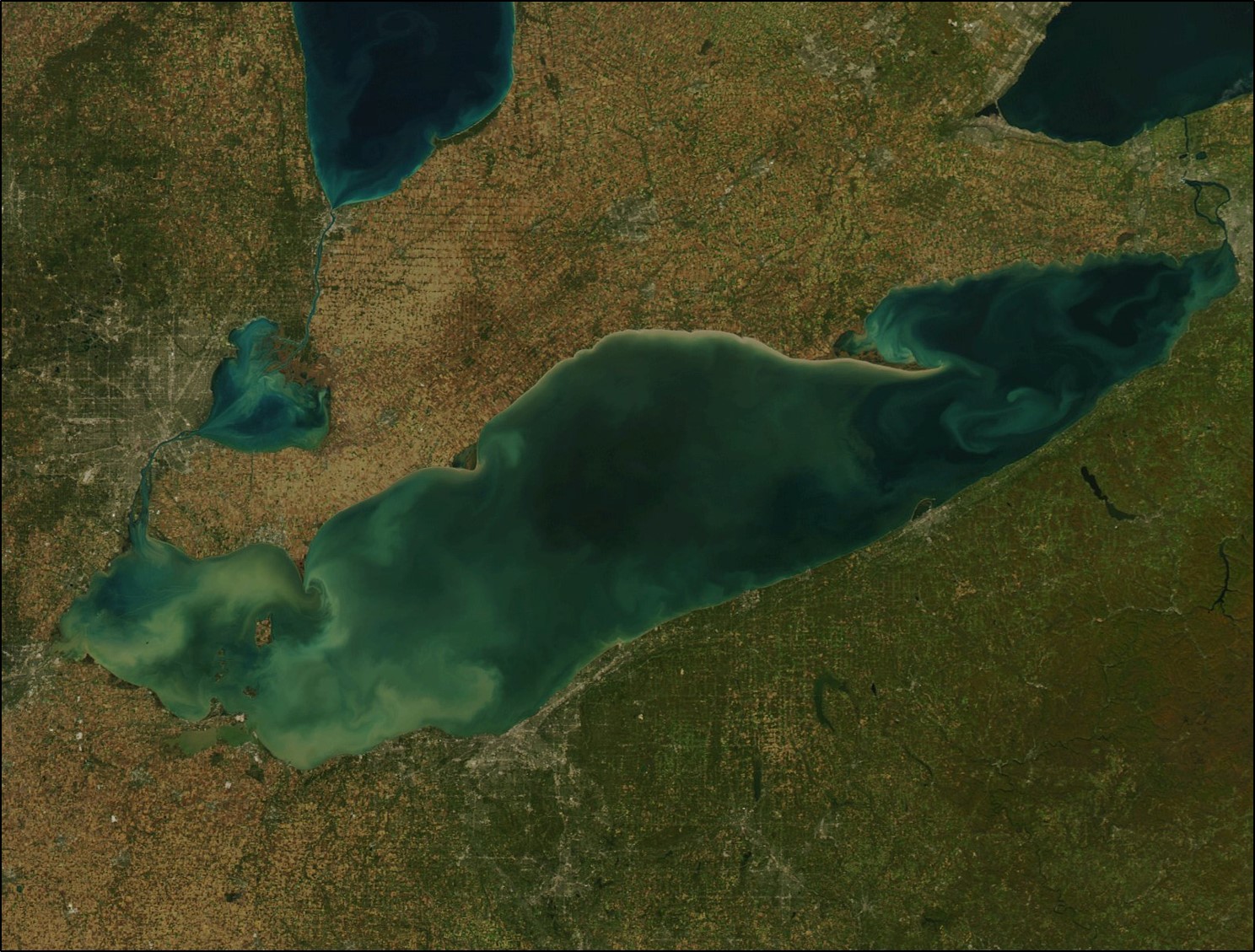Winter 2020 eNewsletter
Featured Research
Assessing Environmental Changes in the Lake Erie Ecosystem
During the past century, the ecosystems of the Laurentian Great Lakes have been in states of flux. Specifically, Lake Erie has been a highly dynamic ecosystem, challenged by human impacts including pollution, introduced species, increased nutrient inputs, climate change and land-use change. These changes have altered climatic, chemical, physical, and biological conditions and processes and have presented an ongoing challenge to conservationists and management agencies working to sustain the varied ecosystem services that Lake Erie provides.

Satellite image of Lake Erie. Photo Credit: NOAA.
Dr. Michael Fraker is an Assistant Research Scientist for CIGLR focusing on describing ecosystem trends and what is causing them (i.e. their “drivers”) using long-term monitoring data, producing the foundation for an approach NOAA commonly refers to as Ecosystem Based Management or EBM. EBM is an integrated method that incorporates the entire ecosystem, including humans, into resource management decisions, and is guided by an adaptive management approach. “The EBM approach has worked well for marine ecosystems, but has yet to be widely used in the Great Lakes,” says Fraker. “Our research is the first step to observe what linkages and drivers are important for implementing EBM in these ecosystems, starting with Lake Erie”
Of the five Great Lakes, Lake Erie is the smallest (by volume), shallowest and, with approximately 11.6 million people living in its basin, the most densely populated. Lake Erie has long experienced changes because of human activities and natural forces and has been one of the most studied and challenged ecosystems in recent history.
“Lake Erie is well-suited to serve as an example system both within the Great Lakes and globally to study how and why large lake ecosystems have varied over time,” says Fraker. “Our research team collected many of the long-term monitoring datasets for Lake Erie’s western basin beginning in the late 1960s or earlier, including data on the biological, , physical, and socioeconomic features of the lake. As we plot the data we are looking for regime shifts within an ecosystem, what variables if any are correlated with these shifts, and what drivers are most important.”
In ecology, regime shifts are large, abrupt, persistent changes in the structure and function of an ecosystem. Recently, many examples of regime shifts have been documented worldwide, especially in marine ecosystems, and understanding their mechanisms and consequences is of great importance for the sustainable use of natural resources and their management.
“Our team is able to use the long-term data sets from Lake Erie to observe environmental and anthropogenic, or human-caused, drivers that play a fundamental role in causing unexpected and sudden shifts between the lake’s ecosystem states,” says Fraker. “Currently, our model observations indicate that nearly all ecosystem variables in our study respond to changes in agriculture and temperature. We also see how the location of organisms within the food web influences their response to alterations in their environment. For example, phytoplankton communities are affected by fluctuations in river discharge and the associated phosphorus levels, which in turn elicits a response by the zooplankton community that preys upon them. Higher up in the food web, fish and birds are not as strongly affected by those changes.”
Prioritizing the different components and services of the Lake Erie environment through a holistic EBM approach balances the diverse and interconnected needs of society and the environment. Individual ecosystem components are intrinsically linked to each other and changes in one component might propagate through the system to influence the various other components.
“Currently, when we talk about ecosystem management we are usually focused on one fish or one species,” says Fraker. “There are many ecosystem trade-offs associated with this kind of management. For example, if managers concentrate only on the Lake Erie walleye population, ecosystem conditions could drastically change or even be made worse, affecting other species such as other fish and birds.”
As a result of this study, workshops with the Great Lakes Fishery Commission, Ohio Department of Natural Resources and NOAA are being planned to present the Lake Erie EBM research and strategize for the next steps of EBM in the Great Lakes.
“Through our research, we hope to advance the ability of agencies to use EBM approaches in the management of Lake Erie and, hopefully, the Great Lakes,” says Fraker. “The data exist for a relatively wide and integrated assessment of the Lake Erie ecosystem and how it has responded to many of the same drivers that affect freshwater systems worldwide. Lake Michigan has numerous long-term monitoring data sets and in the near future, we hope to start a similar study there.”
Dr. Michael Fraker is an Assistant Research Scientist for CIGLR focusing on describing ecosystem trends and their drivers using long-term monitoring data. He uses a variety of empirical, modeling, and statistical approaches across subdisciplines to gain a strong mechanistic understanding of ecosystems, so most of his research is collaborative. This work was supported by funding from the Great Lakes Fishery Commission (2019_FRA_440800).
Additional Resources
DeVanna Fussell, K.M., R.E.H. Smith, M.E. Fraker, and 17 co-authors. 2016. A perspective on needed research, modeling, and management approaches that can enhance Great Lakes fisheries management under changing ecosystem conditions. Journal of Great Lakes Research. 42:742-753. (DOI:10.1016/j.jglr.2016.04.007). [Altmetric Score].
